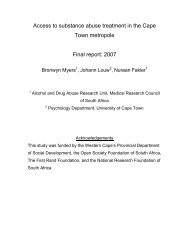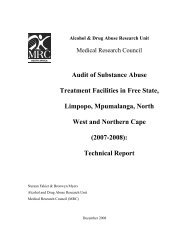Pan-African Conference 21 - 24 July 2002 Inter-Continental Hotel ...
Pan-African Conference 21 - 24 July 2002 Inter-Continental Hotel ...
Pan-African Conference 21 - 24 July 2002 Inter-Continental Hotel ...
Create successful ePaper yourself
Turn your PDF publications into a flip-book with our unique Google optimized e-Paper software.
Abstracts 10/22/02 11:26 AM Page 25<br />
communication tool is insurmountable. According to a report by IDRC (1997),<br />
knowledge is key to sustainable development hence improvements in human<br />
well-being depends on its production, its distribution, ownership and wise<br />
application. ICT is clearly a vehicle through which all communities and<br />
professionals can strive to attain sustainable development. Further, ICT has a<br />
great potential in connecting nations, countries and communities on a global<br />
scale.<br />
But while talk on benefits of ICT continues unabated, one factor that is<br />
abundantly clear is that the food and nutrition situation in sub-Saharan Africa<br />
is wanting. Overall, trend analysis show declining nutritional status while the<br />
food security status is equally cutting. Despite efforts and interventions<br />
towards achieving nutrition and food security, little evidence by way of<br />
improvement is underway. What then should be the way out? The big<br />
challenge now is on nutrition knowledge management. How to take ICT to<br />
communities in a manner that will address their nutritional needs will be<br />
critical to this discussion paper. Of course, it is needless to say that this<br />
proposed discussion would be the first of its kind in this country to determine<br />
how application of ICT can address nutritional problems in society.<br />
As well, this discussion paper believes that the university professionals can<br />
longer remain distanced from community development rather they are capable<br />
of transforming communities by designing, packaging and disseminating<br />
appropriate nutrition messages using information technologies in a<br />
stimulating, user friendly, culturally acceptable and effective manner. At the<br />
moment however, it is sad to note that local communities are not in a position<br />
to access relevant and appropriate nutrition education and information in an<br />
interactive manner.<br />
This paper will therefore offer a critique on utilization of ICT for community<br />
nutrition, but most importantly, it will propose how ICT’s set up in rural<br />
communities can enhance nutritional knowledge and consequently nutritional<br />
well-being.<br />
ABSTRACT NO. <strong>21</strong>4. INFORMATION TECHNOLOGY AS PERTAINS TO<br />
FOOD SCIENCE AND NUTRITION IN EASTERN NIGERIA<br />
Nneoma Elechi Nyelucheya<br />
Dept. of Food Science and Technology, Michael Okpara University of Agriculture,<br />
Abia, State, Nigeria<br />
This paper reviews information technology as an essential tool necessary for<br />
research and development in every civilized society. It also considers the<br />
benefits of adequate exploitation of information technology in good science<br />
and nutrition in Nigeria, such as the enhancement of technological<br />
advancement, enablement of effective processing and preservation of our<br />
abundant food products, and the control of nutrition related diseases. It also<br />
considers the unfortunate situation in the eastern part of our country where<br />
most universities and research institutes lack computers and subsequently are<br />
not linked to the <strong>Inter</strong>net. Also electronic and other journals that have needed<br />
information are not available. Subsequently experiments/researchers are<br />
repeated and often with outdated methodologies. This also leads to lack of<br />
continuity of researches. Finally, this paper also considers possible solutions to<br />
these problems. These include the need to organize workshops and seminars<br />
on the necessity of information technology in Food Science and related fields,<br />
seeking of foreign aids, and getting the government sensitized on the need to<br />
adequately fund the acquisition of information technology in these.<br />
ABSTRACT NO. <strong>21</strong>7. INTERNATIONAL MICRONUTRIENT EDITION OF<br />
CDCYNERGY: A GUIDE TO COMMUNICATION PLANNING<br />
L’édition internationale de micro nutriment CDCynergy: un guide de<br />
planification de la communication<br />
Anderson, B 1 Bobrow EA 1 , Parvanta I 1 , Parvanta C 2 , Brandon V 2 , Cole G 2<br />
Centers for Disease Control and Prevention, Division of Nutrition and Physical<br />
Activity 1 and the Office of Communication 2 , 4770 Buford Hwy NE, MS K-25, Atlanta,<br />
GA 30341 USA<br />
CDCynergy is a CD-Rom based tool that provides a systematic framework for<br />
planning, implementing, managing, and evaluating health communication<br />
programs within a public health context. The <strong>Inter</strong>national Micronutrient<br />
Edition of CDCynergy contains a basic planning framework with a tutorial<br />
which provides written and video instructions plus six case studies adapted<br />
from international micronutrient communication projects conducted by<br />
various agencies (vitamin A supplementation, salt iodization, folic acid<br />
fortification, iron supplementation, dietary improvement and multinutrient<br />
supplementation), a media library with materials from the highlighted<br />
ABSTRACTS<br />
programs, documents and research publications, and a planning workbook.<br />
Users are guided through 6 phases: 1) Problem Definition and Description<br />
(descriptive epidemiology used to define scope and severity); 2) Problem<br />
Analysis (analytic epidemiology utilized to examine at-risk populations and<br />
causal factors); 3) Identifying and Profiling Audiences (based on research); 4)<br />
Developing Communication Strategies and Tactics (to test concepts, messages<br />
and materials); 5) Developing an Evaluation Plan (to integrate evaluation with<br />
the overall program); and 6) Launch/Feedback.<br />
This product is unique in the world of health communication planning tools in<br />
several regards, since it demonstrates the linkage between descriptive<br />
epidemiology, analytical epidemiology, program planning, and evaluation, it<br />
does not assume that communication will be the dominant intervention, it<br />
provides examples of how different countries planned their program,<br />
conducted and interpreted formative research, produced media and evaluated<br />
results, it places program documents, real media, and reference materials on a<br />
CD-Rom, and, it features international program managers and scientists in a<br />
manner that will motivate others to strive for excellence.<br />
ABSTRACT NO. 2<strong>21</strong>. NESTLE NUTRITION INSTITUTE AFRICA: CPD<br />
INITIATIVE<br />
de Beer Anne-Marie 1 , Blaauw R 2<br />
1 Nestlé Nutrition Institute Africa, South Africa<br />
2 University of Stellenbosch, South Africa<br />
The cornerstone of any profession is the continual pursuit of knowledge and<br />
skills. Continuing Professional Development (CPD) is education and training<br />
undertaken beyond the requirements for entry into that profession. CPD is<br />
important to maintain and enhance the image of professionals who are<br />
credible, responsible and accountable for maintaining high standards of<br />
professional practice. It offers members opportunities to move from their<br />
present level of practice to a higher level of practice through planned<br />
professional growth. New legislation in South Africa requires that health<br />
professionals (dietitians and medical practitioners) registered with the Health<br />
Professions Council of South Africa (HPCSA) needs to comply with certain<br />
guidelines regarding CPD in order to remain registered and be allowed to<br />
practice their professions.<br />
Nestlé South Africa, through the Nestlé Nutrition Institute Africa (NNIA),<br />
participated in the CPD activities for dietitians and medical practitioners<br />
registered with the HPCSA since September 2001. The CPD initiative consists<br />
of two different methods, the first of which have already been implemented. All<br />
registered dietitians and selective specialist groups of medical practitioners<br />
have received articles, with questionnaires accredited for CPD points, by post.<br />
After studying the articles, the completed questionnaires have to be send back<br />
for marking. Up to the end of February <strong>2002</strong>, approximately 550 dietitians and<br />
58 medical practitioners have already participated in one or more of these<br />
activities. The overall feedback is very positive and appreciative of the<br />
opportunities provided to them. Furthermore we now have a database of who<br />
have access to the <strong>Inter</strong>net and are using it. Of all our respondents 33% of the<br />
dietitians and 72% of the medical practitioners are using their <strong>Inter</strong>net and email<br />
facilities. Points allocation is accredited in hours spend on the particular<br />
activity. The aim is to provide <strong>24</strong> points for the dietitians per year and 18 for<br />
the medical practitioners this varies between a 1/3 rd and half of the points<br />
required per year by the health worker to stay registered with the Health<br />
professionals council.<br />
Secondly, new articles will be added to the Nestlé nutrition website<br />
(www.nestlenutrition.co.za) every second month as of April <strong>2002</strong>. The topics<br />
will alternate between clinical and paediatric nutrition. Participation to the<br />
latter CPD venture will be by registering on the website free of charge. The<br />
practitioner can download the articles and when ready, the questionnaire can<br />
be completed directly on the website. Feedback on the answers will be<br />
provided immediately.<br />
We trust that health professionals will benefit from this system, not only by<br />
obtaining the necessary CPD points, but also by their own professional growth.<br />
ABSTRACT NO. 222. Computer-aided learning in disadvantaged communities<br />
in the Southern Cape and Karoo: A nutrition education initiative<br />
Venter I 1 , Marais D 2 , De Muynk R 3 , Shedden A 3<br />
1Department of Food and Nutrition, School of Life Sciences, Cape Technikon, PO Box<br />
652, Cape Town, 8000, South Africa<br />
2Department of Human Nutrition, Faculty of Health Sciences, University of<br />
S25

















